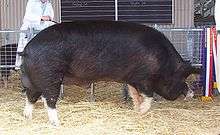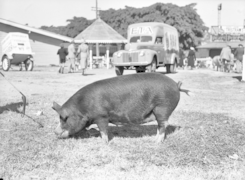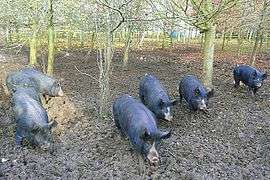Berkshire pig
Berkshire pigs are a breed of pig originating from the English county of Berkshire that are bred and raised in several parts of the world, including England, Japan, the United States, Australia, and New Zealand. The Berkshire pig is not all black, but has white, including white socks from the "knee" down and typically a white blaze on its snout.
 Champion Berkshire boar at the 2005 Royal Adelaide Show | |
| Conservation status | Rare breed |
|---|---|
| Country of origin | England |
| Traits | |
| |
Berkshire pigs are an average to large breed, with an average weight at maturity of 600 lb (270 kg). They are a short-legged breed. They have prick ears and a relatively short snout with an upturned nose.[1]
Appearance
The original Berkshire pig was a reddish or sandy-brown, sometimes with spots.[2][3] In the 1700s, breeders made improvements by cross-breeding the Berkshire with a Chinese and Siamese pig introduced into British agriculture. This is when the breed took on the distinctive entirely black color, with white on the feet, nose, and tail. More important than the coloration, breeders were pleased with the improved meat quality.
Culinary
Berkshire pork, prized for juiciness, flavour, and tenderness, is pink-hued and heavily marbled. Its high fat content makes it suitable for long cooking and high-temperature cooking.[4] The meat also has a slightly higher pH, according to food science professor Kenneth Prusa of Iowa State University. Increased pH makes the meat darker, firmer, and more flavorful. High pH is a greater determinant than fat content in the meat's overall flavor characteristics.[5]
Kurobuta
The Japanese have bred the Kurobuta branch of the Berkshire breed for increased fineness in the meat and better marbling.[6] Pigs' fat stores many of the characteristics of the food that they eat. Berkshire pigs are usually free-ranging, often supplemented with a diet of corn, nuts, clover, apples, or milk.[7] Japanese Kurobuta Pork comes from a strain of Berkshire pig imported to Japan in the 19th century. Kurobuta pork sold elsewhere comes from Berkshire pigs.[8][9]
Berkshire/Kurobuta pork fetches a premium price. At a U.S. grocery store, conventional pork chops fetched $3-4/lb in 2015, $13-15/lb in 2019. The typical cost for a six-ounce Kurobuta pork chop ranged between $10-14.[10]
Countries of production
England
Berkshire pigs are thought to have originated in Reading, the county seat of Berkshire. It is one of the oldest breeds of pigs in England. It was the first breed to record pedigrees in herd books.[3] Herds of the breed are still maintained in England by the Rare Breeds Survival Trust at Aldenham Country Park, Hertfordshire, and by the South of England Rare Breeds Centre in Kent. The Berkshire was listed as vulnerable in 2008; as of 2008, fewer than 300 breeding sows were known to exist at that time, but with the revived popularity of the breed through its connection to the Japanese marketing of a "wagyu for pork" connection, the numbers have increased.[11])[10]
Japan
The pig is also bred in Kagoshima Prefecture, Japan, under the trademarked name Kagoshima Kurobuta (かごしま黒豚, "Kagoshima black pig"). Berkshire swine were introduced to Kagoshima via the Ryukyu Islands. Since the Meiji period in Japan, pig farming has broadened and proliferated until it became one of the leading agricultural industries of the prefecture. Beginning in the late 19th century, Japanese farmers and breeders have worked to improve the quality of their Berkshire herds. Japanese Berkshire pigs are bred for improved meat flavor characteristics. Sub-bred are “Satsuma”, “New Satsuma”, “Satsuma Ni-Rei-Rei-Ichi.”[6]
New Zealand and Australia
Some pigs of the breed are also kept in New Zealand and Australia, but fewer than a hundred purebred sows are there now.
United States
In the United States, the American Berkshire Association, established in 1875, gives pedigrees only to pigs directly imported from established English herds or to those tracing directly back to such imported animals.[4] The association was the first Swine Registry to be established and the first hog recorded was "Ace of Spades", a boar bred by Queen Victoria.[12] Some farmers prefer to import and raise the Japanese pigs and maintain their care and feeding in a way that will allow them to be certified in Japan as American Kurobuta.
In literature
- Empress of Blandings, in P. G. Wodehouse's Blandings Castle series of novels and stories, and the sow Pig-Wig, in Beatrix Potter's The Tale of Pigling Bland, were both Berkshires.
- The antagonist pig Napoleon in George Orwell's novel Animal Farm is a Berkshire boar.
Gallery
References
- Ekarius, Carol (19 February 2009). "Berkshire Pigs For Small Farms".
- American Berkshire Association (18 April 1996). "Breeds of Livestock - Berkshire Swine".
- Berkshire - New Zealand Pig Breeders Association website
- Zeldes, Leah A. (27 January 2010). "Eat this! Berkshire pork, a meaty heritage". Dining Chicago. Chicago's Restaurant & Entertainment Guide, Inc. Retrieved 27 January 2010.
- Premium (High-End) Pork Cooks Illustrated, July, 2011
- Kagoshima Kurobuta Pork ~ A Deliciousness ought to be Savoured by Everyone in the World - Kagoshima Prefecture Website (Official)
- Fact File: Kurobuta Pork - Luxury Insider, 23.12.2010
- D'Artagnan (9 May 2017). "Food Fight: Berkshire Pork vs. Kurobuta Pork". Cener of the Plate. Retrieved 7 October 2019.
- "What Is Kurobuta Pork?". Food Republic. 25 January 2013. Retrieved 7 October 2019.
- "What is Kurobuta Pork? - Complete Carnivore". Complete Carnivore. 6 March 2015. Retrieved 2 October 2018.
- Rare Breeds Survival Trust watch list Archived 31 July 2008 at the Wayback Machine accessed 21 May 2008.
- "History – American Berkshire Association". Retrieved 28 May 2019.
External links
| Wikimedia Commons has media related to Berkshire pig. |



_(19888961623).jpg)